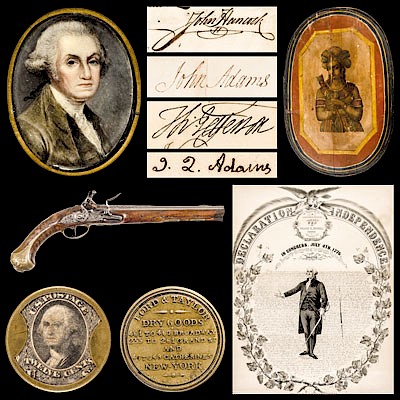1786 Engraved Portrait British Admiral Parker - Revolutionary War Era
Lot 175
Estimate:
$250 - $300
Absentee vs Live bid
Two ways to bid:
- Leave a max absentee bid and the platform will bid on your behalf up to your maximum bid during the live auction.
- Bid live during the auction and your bids will be submitted real-time to the auctioneer.
Bid Increments
| Price | Bid Increment |
|---|---|
| $0 | $10 |
| $200 | $20 |
| $300 | $25 |
| $500 | $50 |
| $1,000 | $100 |
| $2,000 | $200 |
| $3,000 | $250 |
| $5,000 | $500 |
| $10,000 | $1,000 |
| $20,000 | $2,000 |
| $30,000 | $2,500 |
| $50,000 | $5,000 |
| $100,000 | $10,000 |
| $200,000 | $20,000 |
| $300,000 | $25,000 |
| $500,000 | $50,000 |
About Auction
By Early American History Auctions
Jun 1, 2019
Set Reminder
2019-06-01 12:00:00
2019-06-01 12:00:00
America/New_York
Bidsquare
Bidsquare : Historic Autographs, Colonial Currency, Political Americana & Revolutionary War Era
https://www.bidsquare.com/auctions/early-american-history-auctions/historic-autographs-colonial-currency-political-americana-revolutionary-war-era-4152
Historic Autographs, Coins, Currency, Political, Americana, Historic Weaponry and Guns, John Adams, Thomas Jefferson, Early American History Auctions auctions@earlyamerican.com
Historic Autographs, Coins, Currency, Political, Americana, Historic Weaponry and Guns, John Adams, Thomas Jefferson, Early American History Auctions auctions@earlyamerican.com
- Lot Description
American Revolution
1786 Engraved Portrait Rev. War British Admiral Parker
March 10, 1786-Dated, Engraved Portrait of British Admiral Parker, Historic Revolutionary War Era Military Figure, Published by J. Fielding, London, 1786, Engraved by Birrell, Choice Crisp Mint.
This original print measures 7.5" x 4.5" being a Plate or Frontispiece from a period British magazine. Sir Hyde Parker (1739 - 1807), was a British Admiral who distinguished himself in the American Revolutionary War in breaking the defences of the North River at New York in 1776. A beautiful, exceptional quality, engraved portrait of British Admiral Parker.
Admiral Sir Hyde Parker (1739-1807), second son of Admiral Sir Hyde Parker, 5th Baronet (1714-1783), entered the Royal Navy at an early age, and became lieutenant on 25 January 1758, having passed most of his early service in his fathers' ships.
Five years later - on 18 July 1763 - he became a post-captain, and from 1766 onwards for many years he served in the West Indies and in North American waters, particularly distinguishing himself in breaking the defences of the North River at New York in 1776. His services on this occasion earned him a knighthood in 1779. In 1778 he was engaged in the Savannah expedition, and in the following year his ship was wrecked on the hostile Cuban coast. His men, however, entrenched themselves, and were in the end brought off safely. Parker was with his father at the Battle of Dogger Bank, and with Richard Howe in the two actions in the Straits of Gibraltar. He reached flag rank on 1 February 1793, the same day that war was declared against the new French Republic. As Rear Admiral, he served under Samuel Hood at Toulon and in Corsica. He was promoted to Vice-Admiral on 4 July 1794 and took part, under The Lord Hotham, in the indecisive fleet actions on 13 March 1795 and 13 July 1795. From 1796 to 1800 he was in command at Jamaica and ably conducted the operations in the West Indies.
He became a full Admiral on 14 February 1799. In 1801 he was appointed to command the fleet destined to break up the northern armed neutrality, with Vice-Admiral Horatio Nelson as his second-in-command. Copenhagen, the first objective of the expedition, fell in the Battle of Copenhagen on 2 April 1801 to the fierce attack of Nelson's squadron - Parker, with the heavier ships, taking little part. At the height of the battle Parker raised the flag to disengage. Famously, Nelson ignored the order from his commander by raising his telescope to his blind eye and exclaiming "I really do not see the signal". Nelson pressed on with the action and ultimately compelled the Danish forces to capitulate. Parker's hesitation to advance up the Baltic Sea after his victory was later severely criticised. Soon afterwards he was recalled and Nelson succeeded him. In 1800, he married his second wife, Frances, daughter of Sir Richard Onslow, 1st Baronet, and made their home at the manor house Benhall Lodge in Suffolk. He died on 16 March 1807.
His son - the third Hyde Parker (1786-1854) - became a Rear-Admiral in turn on 23 November 1841 and Vice-Admiral on 4 June 1852. From 1853 he served as First Sea Lord of the Royal Navy, but died on 25 May 1854. (From Wikipedia)
- Shipping Info
-
Early American provides in-house worldwide shipping. Please contact us directly if you have questions about your specific shipping requirements.
-
- Buyer's Premium



 EUR
EUR CAD
CAD AUD
AUD GBP
GBP MXN
MXN HKD
HKD CNY
CNY MYR
MYR SEK
SEK SGD
SGD CHF
CHF THB
THB












